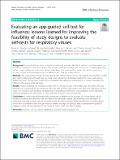| dc.contributor.author | Zigman Suchsland, Monica L. | |
| dc.contributor.author | Rahmatullah, Ivan | |
| dc.contributor.author | Lutz, Barry | |
| dc.contributor.author | Lyon, Victoria | |
| dc.contributor.author | Huang, Shichu | |
| dc.contributor.author | Kline, Enos | |
| dc.contributor.author | Graham, Chelsey | |
| dc.contributor.author | Cooper, Shawna | |
| dc.contributor.author | Su, Philip | |
| dc.contributor.author | Smedinghoff, Sam | |
| dc.contributor.author | Chu, Helen Y. | |
| dc.contributor.author | Sewalk, Kara | |
| dc.contributor.author | Brownstein, John S. | |
| dc.contributor.author | Thompson, Matthew J. | |
| dc.date.accessioned | 2021-11-01T14:34:03Z | |
| dc.date.available | 2021-11-01T14:34:03Z | |
| dc.date.issued | 2021-06-29 | |
| dc.identifier.uri | https://hdl.handle.net/1721.1/136897 | |
| dc.description.abstract | Abstract
Background
Seasonal influenza leads to significant morbidity and mortality. Rapid self-tests could improve access to influenza testing in community settings. We aimed to evaluate the diagnostic accuracy of a mobile app-guided influenza rapid self-test for adults with influenza like illness (ILI), and identify optimal methods for conducting accuracy studies for home-based assays for influenza and other respiratory viruses.
Methods
This cross-sectional study recruited adults who self-reported ILI online. Participants downloaded a mobile app, which guided them through two low nasal swab self-samples. Participants tested the index swab using a lateral flow assay. Test accuracy results were compared to the reference swab tested in a research laboratory for influenza A/B using a molecular assay.
Results
Analysis included 739 participants, 80% were 25–64 years of age, 79% female, and 73% white. Influenza positivity was 5.9% based on the laboratory reference test. Of those who started their test, 92% reported a self-test result. The sensitivity and specificity of participants’ interpretation of the test result compared to the laboratory reference standard were 14% (95%CI 5–28%) and 90% (95%CI 87–92%), respectively.
Conclusions
A mobile app facilitated study procedures to determine the accuracy of a home based test for influenza, however, test sensitivity was low. Recruiting individuals outside clinical settings who self-report ILI symptoms may lead to lower rates of influenza and/or less severe disease. Earlier identification of study subjects within 48 h of symptom onset through inclusion criteria and rapid shipping of tests or pre-positioning tests is needed to allow self-testing earlier in the course of illness, when viral load is higher. | en_US |
| dc.publisher | BioMed Central | en_US |
| dc.relation.isversionof | https://doi.org/10.1186/s12879-021-06314-1 | en_US |
| dc.rights | Creative Commons Attribution | en_US |
| dc.rights.uri | https://creativecommons.org/licenses/by/4.0/ | en_US |
| dc.source | BioMed Central | en_US |
| dc.title | Evaluating an app-guided self-test for influenza: lessons learned for improving the feasibility of study designs to evaluate self-tests for respiratory viruses | en_US |
| dc.type | Article | en_US |
| dc.identifier.citation | BMC Infectious Diseases. 2021 Jun 29;21(1):617 | en_US |
| dc.contributor.department | Massachusetts Institute of Technology. Center for Transportation & Logistics | |
| dc.identifier.mitlicense | PUBLISHER_CC | |
| dc.eprint.version | Final published version | en_US |
| dc.type.uri | http://purl.org/eprint/type/JournalArticle | en_US |
| eprint.status | http://purl.org/eprint/status/PeerReviewed | en_US |
| dc.date.updated | 2021-07-04T03:21:13Z | |
| dc.language.rfc3066 | en | |
| dc.rights.holder | The Author(s) | |
| dspace.date.submission | 2021-07-04T03:21:13Z | |
| mit.license | PUBLISHER_CC | |
| mit.metadata.status | Authority Work and Publication Information Needed | |
